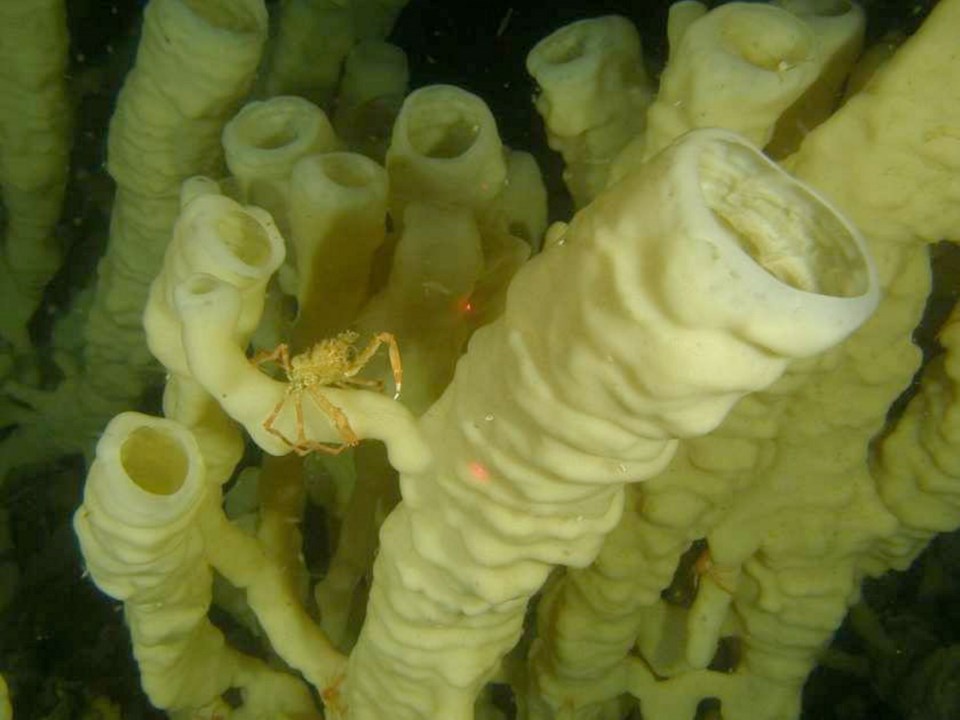A friend tells me that, back in the 1970s, he used to dive in Saanich Inlet to visit a local reef. He says it was spectacular. It included strange, pillowy sponges and a community of shrimps, crabs, fish and other critters.
But, he says, the reef vanished decades ago.
With the critters gone and any remains buried under 40 years of sediment, it would be difficult to determine if the reef had been one of B.C.’s now-iconic glass-sponge reefs. With hard tissues made of tiny shards of silicate minerals — glass — the sponges are extremely fragile. A crab pot dragged across a reef, for example, can shatter the sponges into smithereens. Equipment from a bottom trawler can plow swathes through them.
Long thought to be extinct, living glass-sponge reefs were discovered in the deep waters of Hecate Strait and Queen Charlotte Sound in the late 1980s. Scientists have since located glass-sponge reefs in shallower waters in Howe Sound, off Tsawwassen and Parksville, and off Bowen, Mayne, Galiano and Gabriola islands, and in Chatham Sound near Prince Rupert. Similar reefs have also been found in Alaska’s Lynn Canal and off Washington state.
And more keep coming to light. Underwater surveyors found two new reefs this year near Port Hardy.
Glass-sponge reefs provide refuge and habitat for many species such as rockfish, finfish and shellfish. They’re also champion water filters. An average-sized sponge can filter about 70 litres each hour, according to B.C. researchers. Together, a reef can clean all of the water in Howe Sound in a year. Other research shows the sponges’ diet of bacteria mean they also sequester carbon from seawater, an important benefit under climate change.
This coast is the only place in the world where these reefs are known to exist today. They are thought to have started developing at the end of the last Ice Age, about 9,000 years ago.
The reefs receive little recognition for the work they do — for free — to keep our ocean water clean, soak up carbon, and make homes for important fish and shellfish species. Despite their age, global rarity and extreme fragility, the reefs have little formal protection, and the sponge species that make up the reefs appear on no endangered or at-risk species lists.
In a step in the right direction, the federal government created a 2,000-square-kilometre marine conservation area last year that comprises three reefs in Hecate Strait and Queen Charlotte Sound. Fishing is banned in those areas.
The fishing industry has also developed standards and best practices for activity around known reefs. Despite that, studies have shown those efforts have only slowed the rate of damage over the past 30 years.
A glass-sponge reef can be damaged in many ways. Although glass sponges feed on bacteria and small particles in seawater, when the water around a reef contains too much sediment, they suffer.
Sponges breathe by absorbing oxygen from the water that they pump through their bodies. When the sponge detects sediment, an electrical signal races through the organism’s tissues, suspending the pumping that takes in water. By stopping the flow of water, they stop breathing. The stop-work can last anywhere from two to 10 minutes, but when sediment hangs about in the water for longer periods, the sponges may repeat the process several times, starting up to see if the water is clear enough to breathe and feed.
Some highly sensitive species stop pumping for as long as six hours when the water contains too much sediment. Where sedimentation is constant — where seafloor dredging or construction is occurring, where a river discharge, sewage outfall or fish farm constantly washes sediment onto a reef, the prolonged arrested pumping can repeat. Again. And again.
Not breathing or feeding for extended periods of time rarely ends well for any creature.
One of the reefs discovered this year is located beneath a fish farm — a poor choice of location. Sediment from the farm had killed the reef. The other reef, some distance away, is healthy.
The reefs are valuable, sensitive and fragile. It doesn’t take much to damage or kill them or sweep them away. It seems foolish not to protect natural features that, at no cost to us, purify our coastal water and provide critical nurseries for economically valuable fish and shellfish species.



